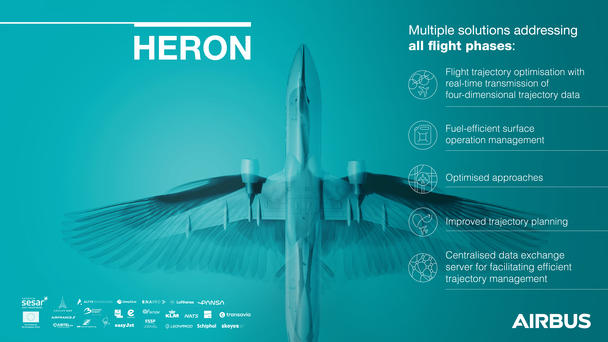In nature, herons are graceful birds known for their ability to adapt with ease to changing environmental conditions. In aviation, HERON is the name given to a recently-started SESAR Digital Sky Demonstrator supporting the delivery of more fuel-efficient flight operations.
Over a period of three years, HERON (Highly Efficient gReen OperatioNs) aims to show how the introduction of optimised air traffic management operations and new technologies can mitigate aviation’s environmental footprint and reduce fuel consumption and emissions.
Co-funded within the framework of the Connecting Europe Facility, the Demonstrator is led by SESAR 3 JU member, Airbus, which brings together partners across 10 countries, representing the full aviation ecosystem including airlines, airports, air traffic control agencies and service providers.
From ALBATROSS to HERON: Europe at the forefront of innovation
HERON is an expanded follow-on to ALBATROSS, a two-year very large-scale demonstration, which performed a series of gate-to-gate live trials across Europe for fuel-efficient flights. ALBATROSS brought together innovations such as optimised flight operations from climb-out to the descent for landing, followed by hybrid assistance for aircraft movements on the ground.
A hybrid taxiing solution to reduce aircraft fuel consumption
With HERON, the goal is to pursue the deployment of already-mature solutions as steps that contribute toward achieving the air transport industry’s objective of "net-zero carbon emissions by 2050," as set by IATA, ATAG and ICAO.
A key focus of HERON is the management of fuel-efficient on-ground aircraft operations. This will include aircraft taxiing without use of engines for momentum and the optimisation of airplane movements at airports by avoiding unnecessary waiting times on taxiways and at parking stands. It will include the green apron management demonstration, which uses sensors and artificial intelligence for more predictable and efficient aircraft handling during airport stopovers.
For airborne operations, one of the HERON work packages will aim to improve air traffic control management of in-flight trajectories through enhanced network coordination. Another work package will see the implementation of smoother, more continuous descent profiles as aircraft near their destinations, which will involve flights into airports in Brussels, Istanbul, Warsaw, Calvi and Saint-Nazaire.
More about HERON
More about ALBATROSS
More about SESAR Digital Sky Demonstrators

